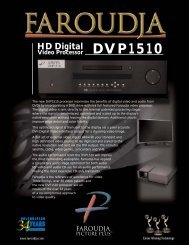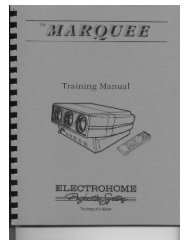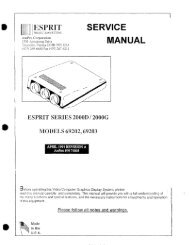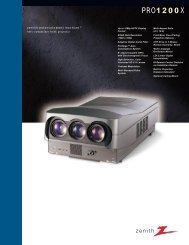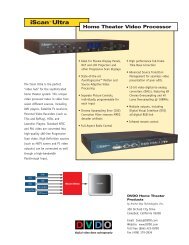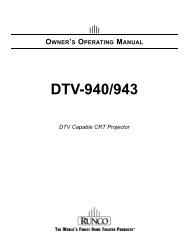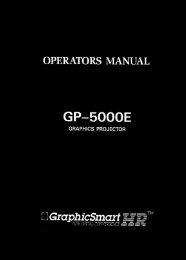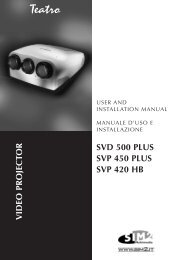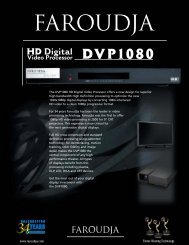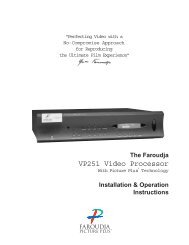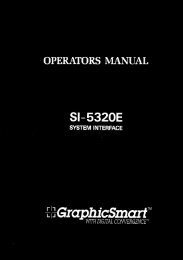Barco LIDO Brochure/Spec Sheet - CurtPalme.com
Barco LIDO Brochure/Spec Sheet - CurtPalme.com
Barco LIDO Brochure/Spec Sheet - CurtPalme.com
You also want an ePaper? Increase the reach of your titles
YUMPU automatically turns print PDFs into web optimized ePapers that Google loves.
<strong>LIDO</strong>Built-in Video Line Doubler forBARCO Projectors and RCVDS 05 SwitcherBARCO’s <strong>LIDO</strong> is a proprietary,state-of-the-art digital Video LineDoubler (31.25 kHz) which maybe incorporated into mostcurrent BARCO CRT projectors, orinto BARCO’s RCVDS 05 Switcher.It greatly reduces visible linestructure inherent in videoimages and produces a smoother,more film-like video image.BARCO’s <strong>LIDO</strong> works in unison with the VideoDecoder of the projector, which incorporates a threelineadaptive Comb Filter and special EnhancementCircuit.• The three-line adaptive Comb Filter improves colortransitions and reduces noise in the video signal.• The Enhancement Circuit integrated in the decoderprovides sharper images with clearer outlines.• The LiDo line doubling circuit reduces visible linestructure by doubling the number of lines of thevideo image through BARCO’s digital Smart MotionDetection Filtering. An integrated, specially designedPhase Locked Loop (PLL) circuit stabilizes the imagequality, especially when using poor quality videotapes.These three circuits work in unison to produce asmoother yet sharper image which is significantlymore appealing when watching video images.
Superior Video Quality through BARCO’sIntelligent Video Processing AlgorithmsBARCO’s LiDo works together withthe built-in digital Video Decoderof the projector, whichincorporates a three-line adaptiveComb Filter and a specialEnhancement circuitThree-line AdaptiveComb FilterThe three-line adaptive CombFilter guarantees perfect colortransitions and rendersexceptional image detail. Videonoise in the image is significantlyreduced. This filter is based on a2-line delay for NTSC and a 4-linedelay for PAL, and utilizes8-bit in / 10 bit out AD/DAconvertors.Sophisticated image processingalgorithms guarantee optimalhorizontal resolution.Enhancement CircuitThe Enhancement Circuitintegrated in the decoderimproves image contours andenhances the useful range of thesharpness control. This circuit isparticularly effective in reducingringing effects on luminancetransitions in order to providemaximum image quality.Line DoublerBARCO’s <strong>LIDO</strong> is an 8-bit digitalmotion adaptive line doubler.Pixel reproduction is based onadvanced Smart MotionDetection filtering, which takesinto account pixel informationfrom the previous line, thefollowing line and the previousimage field. The outputfrequency of the LiDo is31.25 kHz, 50 or 60 Hz(depending on the vertical inputfrequency). A specially designedPLL circuit is used to stabilize theimage quality when using poorquality VHS tapes.Advanced Smart Motion Detection Filter1. Line Repetition 2. Field Insertion 3. Smart Motion Detection Filterinterlaced non-interlaced interlaced non-interlaced interlaced non-interlaced1'1'1'1'1'2'2'2'2'2'field 1field 1field 11"2"1"1"2"2"1"2"1"1'2"2'1"2"1'+1"1"2'+2"2"field 2field 2field 2Basically, there are threedifferent line doublingtechniques: line repetition, fieldinsertion and smart motiondetection filtering.Line RepetitionEvery line in a frame isduplicated (figure 1). This is arather simple technique , whichdoes not totally eliminate lineflicker, with poor results onimages with diagonal lines.However, this technique has nomotion artifacts.Field InsertionWith field insertion (figure 2), linedoubling is done by copying thecorresponding line of theprevious field between two linesof the current field. Since thissystem <strong>com</strong>bines informationfrom different time slots(different fields) in one field, ithas poor results with images witha lot of motion. However, thistechnique is the ideal solution forstill video images.Smart Motion DetectionFilteringBARCO’s LiDo makes use ofadvanced digital Smart MotionDetection Filtering. Thisenhanced line doublingtechnique takes into accountpixel information from theprevious line, the following lineand the previous image field(figure 3). This results in asmooth, line flicker free imagequality, with almost no motionartifacts. This method is theideal line doubling solution forthe highest quality videoimages.
BARCO’s digital Line Doublerincorporates adaptive line and fieldmemory processing to significantlyreduce visible line structure in theprojected image.The result is asmoother, more film-like image.Picture left: standard video projection.Picture right: video projection withBARCO’s built-in <strong>LIDO</strong>(Actual projected images).CleansignalFast PLLPrevious linewith Sync noise trackingNext linewith noiseVideo signalSyncSync trackingSync trackingSlow PLLSync trackingSync trackingSync trackingProjected vertical line with fast PLLThe PLL circuit for the sampling of thevideo signal in the LiDo locks on thesync signal.A slow PLL is not sensitive for noise, buthas a slow response to shifts in the syncsignal (e.g. with poor quality VHS tapes),which results in a ‘bending’ at the top ofthe image.A fast PLL immediately responds to syncshifts, but results in jitter of the videoimage when there is noise in the syncsignal.BARCO has designed an advancedPLL circuit, which has a fast response tosync shifts, but eliminates the influence ofnoise.CleansignalSync trackingSync trackingProjected vertical line with slow PLLPoorqualitytapesSync trackingSync trackingnLine nSync tracking<strong>Spec</strong>ially designed PhaseLocked Loop (PLL) circuitIn BARCO’s LiDo, the in<strong>com</strong>ingvideo signal is sampled before itis processed. A special PLL circuit,locked on the sync signal, is usedto synchronize the sampling ratewith the video signal.Fast PLL circuits immediatelyrespond to sync shifts (e.g. withpoor quality VHS tapes), butresult in image jitter when thereis a lot of noise in the sync signal.Slow PLL circuits are not sensitivefor noise, but have a slowresponse to shifts in the syncsignal, which results in a bendingof the image. BARCO’s speciallydesigned PLL circuit eliminatesthe influence of noise and syncshifts, which results in a verygood and stable image quality.
Technical <strong>Spec</strong>ificationsInputsignalA/DconverterlinememoryfieldmemorySmartmotiondetectionfilterD/AconverterRGBoutputOutput Frequency31.25 kHz/ 50 or 60 HzCompatibilityThe <strong>LIDO</strong> can be built into anynew BARCO 701, 701s, 708, 808s,1208s, 1209s, 1609s Seriesprojector and into the RCVDS 05Source Switcher.Contact BARCO for more detailedinformation on upgrading olderunits.Order Information<strong>LIDO</strong> for BARCO projectorsR9828161<strong>LIDO</strong> for 701 Series(with decoder) R9828160<strong>LIDO</strong> for RCVDS 05R9828280Line Doubler RGB Input RCVDS 05R9828410BARCO Projection Systems is an ISO 9001registered <strong>com</strong>pany.The information and data given are typical for theequipment described. However any individualitem is subject to change without any notice.BARCO Projection Systems - Head OfficeNoordlaan 5 8520 Kuurne, BelgiumTel: +32 / 56 / 368 211 Fax: +32 / 56 / 351 651E-mail: sales.bps@barco.<strong>com</strong>Visit BARCO at the web: http://www.barco.<strong>com</strong>BARCO, Inc.3240 Town Point DriveKennesaw, GA 30144Tel: (770) 218-3200 Fax: (770) 218-3250



